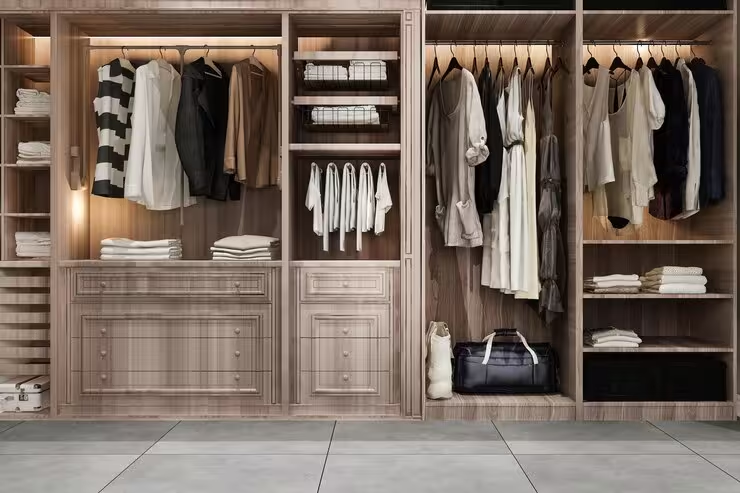
Designing a wardrobe is more than just picking out a few shelves and hangers. It’s about creating a space that’s functional, stylish, and perfectly tailored to your needs. Whether you’re renovating an existing wardrobe or designing a new wardrobe from scratch, there are several key factors to consider to ensure that your wardrobe serves you well for years to come.
Here’s a guide to help you navigate the best wardrobe design process and make informed decisions.
Assess Your Storage Needs
The first step in designing a wardrobe is to assess your storage needs. Take a stock of what you currently have and what you’ll need to store in the future. Consider the types of clothing and accessories you own, including:
– Hanging Clothes: Do you have a lot of dresses, coats, or suits that need hanging space?
– Folded Items: How much space do you need for sweaters, jeans, and other folded clothing?
– Accessories: Do you need compartments for shoes, jewelry, belts, or handbags?
– Special Items: Are there items like hats, scarves, or seasonal clothing that require special storage?
By understanding your storage needs, you can design a wardrobe that maximizes space and keeps everything organized.
Determine the Layout and Configuration
The layout and configuration of your wardrobe are crucial for both functionality and aesthetics. Consider the following options:
– Hanging Rods: Install rods at various heights to accommodate different types of clothing. Double rods can help maximize vertical space, while single rods may be used for longer items like coats and dresses.
– Shelving: Adjustable shelves offer flexibility for storing folded items and accessories. Consider including shelves above hanging rods for additional storage.
– Drawers: Drawers are essential for storing smaller items like socks, underwear, and accessories. Soft-close mechanisms and dividers can enhance their functionality.
– Built-in Units: Custom-built units can be tailored to your specific needs and space, offering a seamless look and maximizing every inch of available space.
Choose the Right Materials and Finishes
The materials and finishes you choose for your wardrobe will impact its durability, style, and maintenance. Here are some options to consider:
– Wood: Wooden wardrobes offer a classic and timeless look. They come in various finishes, from natural wood to painted options. Ensure the wood is treated for durability and resistance to wear and tear.
– Laminate: Laminate is a cost-effective alternative that can mimic the appearance of wood. It’s easy to clean and comes in a range of colors and patterns.
– Glass: Glass panels or doors can add a modern touch and help to visually expand a small space. Frosted or tinted glass can offer privacy while still allowing visibility.
– Metal: Metal finishes, such as brushed stainless steel, can provide a sleek, contemporary look. They are durable and easy to clean, making them ideal for modern designs.
Consider Lighting
Lighting is often an overlooked aspect of wardrobe design, but it’s essential for both functionality and ambiance. Proper lighting helps you see your clothing clearly and enhances the overall look of your wardrobe. Consider the following options:
– Integrated Lighting: Install LED lights within the wardrobe to illuminate shelves and hanging areas. Motion-sensor lights can automatically turn on when the wardrobe doors are opened.
– Spotlights: Use spotlights to highlight specific areas, such as shelves or drawers, making it easier to find items.
– Ambient Lighting: Consider adding ambient lighting to create a pleasant atmosphere and make the wardrobe feel more inviting.
Plan for Accessibility and Flow
A well-designed wardrobe should be easy to access and navigate. Think about the flow of movement within the space:
– Door Style: Choose between hinged, sliding, or bi-fold doors based on your space constraints and personal preferences. Sliding doors are ideal for smaller rooms, while hinged doors offer a classic look.
– Accessibility: Ensure that frequently used items are easily accessible. Position high shelves or deep drawers in a way that doesn’t require you to stretch or bend excessively.
– Workflow: Design the wardrobe layout to support a smooth workflow. Arrange items logically, such as placing everyday clothing at eye level and seasonal items higher or lower.
Incorporate Personal Touches
Personal touches can make your wardrobe not only functional but also a reflection of your style. Consider incorporating:
– Color and Patterns: Choose colors and patterns that complement the rest of your room’s décor. Neutral tones offer versatility, while bold colors can add a pop of personality.
– Custom Details: Add custom features like built-in seating, a vanity mirror, or dedicated sections for accessories to enhance both functionality and comfort.
Budget and Professional Help
Finally, establish a budget for your wardrobe project and consider seeking professional help if needed. Custom wardrobes can vary greatly in cost, so it’s essential to balance your desires with your budget. Hiring a professional designer or contractor can ensure that your wardrobe is designed and installed correctly, maximizing both space and functionality.
Lecco Cucina: Your Partner in Wardrobe Design
At Lecco Cucina, we understand that a well-designed wardrobe is essential to creating a functional and stylish home. Our team of experts is dedicated to providing personalized solutions that cater to your unique needs and preferences. Whether you’re looking for a custom-built wardrobe or seeking advice on optimizing your existing space, Lecco Cucina, the best wardrobe designers in Bangalore offers a range of high-quality options and professional guidance.
Visit our Experience centres today to explore our wardrobe design solutions and discover how we can help you create the perfect storage space for your home. With Lecco Cucina, you can achieve a wardrobe that not only meets your needs but also enhances the beauty and functionality of your living space.
